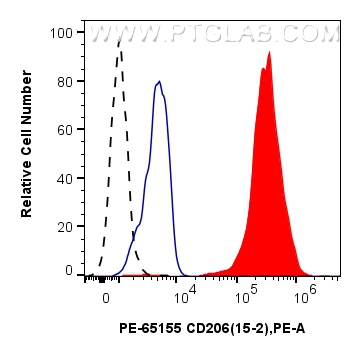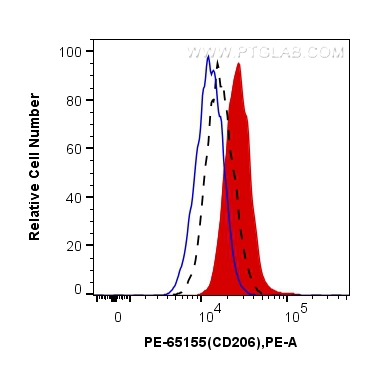验证数据展示
经过测试的应用
| Positive FC detected in | GM-CSF treated human PBMCs |
推荐稀释比
| 应用 | 推荐稀释比 |
|---|---|
| Flow Cytometry (FC) | FC : 5 ul per 10^6 cells in 100 μl suspension |
| This reagent has been pre-titrated and tested for flow cytometric analysis. The suggested use of this reagent is 5 ul per 10^6 cells in a 100 µl suspension or 5 ul per 100 µl of whole blood. | |
| Sample-dependent, Check data in validation data gallery. | |
发表文章中的应用
| FC | See 11 publications below |
产品信息
PE-65155 targets CD206 in FC applications and shows reactivity with human samples.
| 经测试应用 | FC Application Description |
| 文献引用应用 | FC |
| 经测试反应性 | human |
| 文献引用反应性 | human |
| 免疫原 |
Purified human mannose receptor 种属同源性预测 |
| 宿主/亚型 | Mouse / IgG1, kappa |
| 抗体类别 | Monoclonal |
| 产品类型 | Antibody |
| 全称 | mannose receptor, C type 1 |
| 别名 | hMR, C-type lectin domain family 13 member D-like, C-type lectin domain family 13 member D, CLEC13DL, CLEC13D |
| 计算分子量 | 166 kDa |
| GenBank蛋白编号 | NM_002438 |
| 基因名称 | CD206 |
| Gene ID (NCBI) | 4360 |
| RRID | AB_2920521 |
| 偶联类型 | PE Fluorescent Dye |
| 最大激发/发射波长 | 496 nm, 565 nm / 578 nm |
| 形式 | Liquid |
| 纯化方式 | The purified antibody is conjugated with R-phycoerythrin (PE) under optimum conditions. The conjugate is purified by size-exclusion chromatography. |
| UNIPROT ID | P22897 |
| 储存缓冲液 | PBS with 0.09% sodium azide and 0.5% BSA, pH 7.3. |
| 储存条件 | Store at 2-8°C. Avoid exposure to light. Stable for one year after shipment. |
背景介绍
CD206, also named as MMR, CLEC13D and MRC1, is a type I membrane receptor that mediates the endocytosis of glycoproteins by macrophages. CD206 has been shown to bind high-mannose structures on the surface of potentially pathogenic viruses, bacteria, and fungi so that they can be neutralized by phagocytic engulfment. CD206 is a 170 kDa transmembrane protein which contains 5 domains: an amino-terminal cysteine-rich region, a fibronectin type II repeat, a series of eight tandem lectin-like carbohydrate recognition domains (responsible for the recognition of mannose and fucose), a transmembrane domain, and an intracellular carboxy-terminal tail. It is expressed on most tissue macrophages, in vitro derived dendritic cells, lymphatic and sinusoidal endothelia.
实验方案
| Product Specific Protocols | |
|---|---|
| FC protocol for PE CD206 antibody PE-65155 | Download protocol |
| Standard Protocols | |
|---|---|
| Click here to view our Standard Protocols |
发表文章
| Species | Application | Title |
|---|---|---|
Oncogene Dual role of pseudogene TMEM198B in promoting lipid metabolism and immune escape of glioma cells | ||
J Agric Food Chem Polysaccharide from Ziyang Selenium-Enriched Green Tea Prevents Obesity and Promotes Adipose Thermogenesis via Modulating the Gut Microbiota | ||
Cancer Immunol Immunother SUMO modified ETV1 promotes M2-polarized tumor-associated macrophage infiltration and cancer progression by facilitating CCL2 transcription in esophageal squamous cell carcinoma cells | ||
Hum Cell Hypoxic breast cancer cell-derived exosomal miR-143-3p targets RICTOR to regulate M2 macrophage polarization, thereby modulating cancer cell invasiveness | ||
Biomed Pharmacother Vorinostat decrease M2 macrophage polarization through ARID1A6488delG/HDAC6/IL-10 signaling pathway in endometriosis-associated ovarian carcinoma | ||
Eur J Histochem Tumor cells-derived exosomal PD-L1 promotes the growth and invasion of lung cancer cells in vitro via mediating macrophages M2 polarization |



